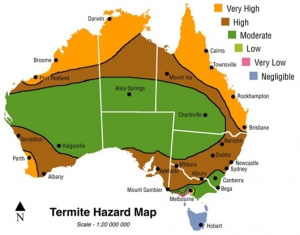Every year termite infestations cause millions of dollars in damage to timber in homes across Australia. In most cases the foraging termites are eating away at the timbers and are undetected until the damage is severe and costly to repair. Termites are also known as ‘White Ants’ and are grouped into two basic categories; drywood termites and subterranean termites. The most common termites are subterranean which means they are underground.
Termites are a threat
Subterranean termites are generally the main threat. Termites live in colonies, the colony has soldier termites, worker termites and reproductive termites; with each termite having their role in maintaining and contributing to the success of the colony. The worker termites make up the majority of the colony, they are sterile, wingless and blind; they are responsible for building the nest, gathering food and tending to the eggs and the young. The worker termites are sent from the nest in search of food, they will commute between the nest and the food source. The soldier termites are also sterile, wingless and blind, they are responsible for protecting the colony against predators for example ants. The reproductive termites are the colonies potential king and queens. Termites can build their nests underground, in large pieces of timber, high up in trees or inside tree trunks. Tree stumps are ideal for termites to nest in; it is for this reason we will always recommend to remove stumps found in yards, however we are aware that sometimes it is not affordable nor practical to do which is why we recommend the option to treat the stumps chemically. Termites live in colonies in the nests they build; a mature colony can have anywhere from several hundred to several million individual termites. Some subterranean queens can lay up to 2000 eggs per day. A single colony can exist for as long as 50 years. Below is a map showing high hazard areas for subterranean termite infestations. As you can see the Sunshine Coast area is considered very high risk. We recommend that home owners be vigilant in protecting their homes by having regular termite inspections and installing termite management systems.

We are often asked how do termites get in as many of us don’t even know they are eating our homes until the damage has happened. Termites find our homes offer an ideal combination of moisture, food and warmth. As the termites eat from the inside of timber and very seldom will break through the surface of the timber you won’t notice any evidence of damage.
Australian Standards recommend at least an annual termite inspection of homes and sometimes we will recommend inspections be carried out at more frequent intervals depending if you have a termite management system in place, the design & construction of you home and also the surrounding environmental conditions. Our termite inspections are carried out in accordance with the Australian Standards AS3660.2. We offer obligation free advice on termite management for your home.
